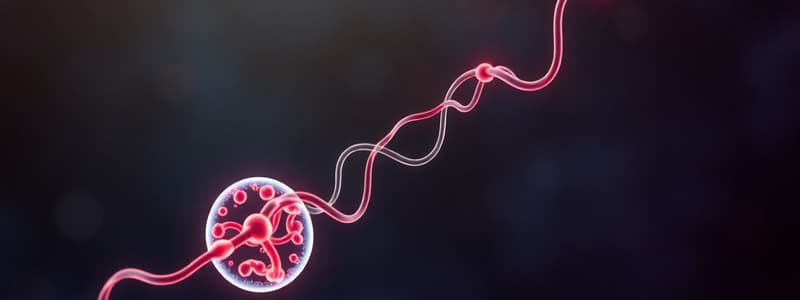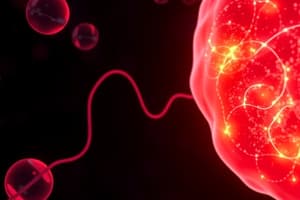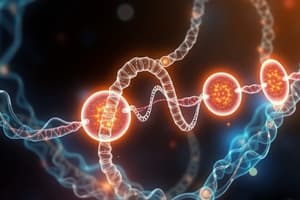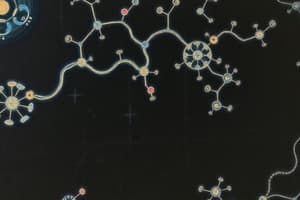Podcast
Questions and Answers
What are the primary end products of glycolysis?
What are the primary end products of glycolysis?
- Glucose and ATP
- Carbon dioxide and water
- Pyruvate, ATP, and NADH (correct)
- Ethanol and lactic acid
In which types of respiration does glycolysis occur?
In which types of respiration does glycolysis occur?
- Only anaerobic respiration
- Neither aerobic nor anaerobic respiration
- Both aerobic and anaerobic respiration (correct)
- Only aerobic respiration
How many phases is glycolysis composed of?
How many phases is glycolysis composed of?
- Three
- Four
- One
- Two (correct)
In the initial phase of glycolysis, what is required?
In the initial phase of glycolysis, what is required?
During the second phase of glycolysis, what happens to the chemical energy from the intermediates?
During the second phase of glycolysis, what happens to the chemical energy from the intermediates?
What is the fate of pyruvate molecules produced during glycolysis?
What is the fate of pyruvate molecules produced during glycolysis?
Which of the following best describes the role of ATP in carbohydrate metabolism?
Which of the following best describes the role of ATP in carbohydrate metabolism?
How many ATP molecules are typically produced from the complete breakdown of one molecule of glucose via aerobic respiration?
How many ATP molecules are typically produced from the complete breakdown of one molecule of glucose via aerobic respiration?
Which processes are involved in the complete breakdown of glucose by aerobic respiration?
Which processes are involved in the complete breakdown of glucose by aerobic respiration?
Which process directly provides the most energy during the complete breakdown of glucose?
Which process directly provides the most energy during the complete breakdown of glucose?
Which of the following statements accurately describes the role of glycolysis in different organisms?
Which of the following statements accurately describes the role of glycolysis in different organisms?
What determines the differences in glycolytic pathways between organisms?
What determines the differences in glycolytic pathways between organisms?
What is the net gain of ATP molecules directly from glycolysis per molecule of glucose?
What is the net gain of ATP molecules directly from glycolysis per molecule of glucose?
Where does glycolysis take place in the cell?
Where does glycolysis take place in the cell?
Which molecule is regenerated during glycolysis, allowing the pathway to continue?
Which molecule is regenerated during glycolysis, allowing the pathway to continue?
What is the significance of glycolysis in red blood cells?
What is the significance of glycolysis in red blood cells?
What is the role of hexokinase in glycolysis?
What is the role of hexokinase in glycolysis?
Which enzyme catalyzes the committed step of glycolysis?
Which enzyme catalyzes the committed step of glycolysis?
How is glycolysis regulated?
How is glycolysis regulated?
What is produced when glycolysis occurs under anaerobic conditions?
What is produced when glycolysis occurs under anaerobic conditions?
Flashcards
Glycolysis
Glycolysis
The breakdown of a glucose molecule into two pyruvate molecules, releasing energy stored as ATP and NADH.
Energy molecules in Glycolysis
Energy molecules in Glycolysis
ATP (Adenosine Triphosphate) and NADH (Nicotinamide Adenine Dinucleotide). They store and transfer energy in cells.
Universality of Glycolysis
Universality of Glycolysis
Glycolysis is a fundamental pathway used by nearly all organisms to break down glucose.
Aerobic/Anaerobic respiration
Aerobic/Anaerobic respiration
Signup and view all the flashcards
Phases of Glycolysis
Phases of Glycolysis
Signup and view all the flashcards
First phase of Glycolysis
First phase of Glycolysis
Signup and view all the flashcards
Second phase of Glycolysis
Second phase of Glycolysis
Signup and view all the flashcards
Glycolysis end-product
Glycolysis end-product
Signup and view all the flashcards
Carbohydrate metabolism
Carbohydrate metabolism
Signup and view all the flashcards
ATP yield
ATP yield
Signup and view all the flashcards
Study Notes
Glycolysis Overview
- Glycolysis is the breakdown of a glucose molecule into two pyruvate molecules.
- This process releases energy, stored as ATP and NADH.
- Most organisms that break down glucose use glycolysis.
- Glucose regulation and product use cause the pathways to differ among organisms.
- Glycolysis serves as the only method of energy production in some tissues and organisms.
- The glycolytic pathway is common in both anaerobic and aerobic respiration.
- Glycolysis consists of ten steps divided into two phases.
- The first phase requires the breakdown of two ATP molecules.
- The second phase involves transferring chemical energy from intermediates into ATP and NADH.
- Breaking down one glucose molecule yields two pyruvate molecules.
- Pyruvate can be further oxidized for more energy in later processes.
- Complete glucose breakdown by aerobic respiration, which includes glycolysis, the citric-acid cycle, and oxidative phosphorylation, produces about 30-32 ATP molecules.
Studying That Suits You
Use AI to generate personalized quizzes and flashcards to suit your learning preferences.




